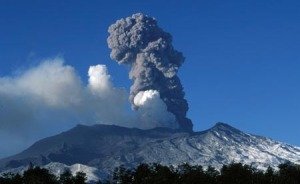A rather unorthodox geoengineering study has examined the potential for greenhouse gases to play a positive role in humanity’s future… if a giant volcanic ash cloud created a global winter by blocking out the sun.
 The paper, published in the journal Geophysical Research Letters, examined the potential for short-lived greenhouse gases to be used to counteract the effect of future volcanic eruptions cooling the Earth by creating sunlight-deflecting clouds of ash. The authors looked at the possible effects on a regional and larger scale, and also at practical, financial and ethical questions.
The paper, published in the journal Geophysical Research Letters, examined the potential for short-lived greenhouse gases to be used to counteract the effect of future volcanic eruptions cooling the Earth by creating sunlight-deflecting clouds of ash. The authors looked at the possible effects on a regional and larger scale, and also at practical, financial and ethical questions.
You can read more about the research on the Guardian website.
Our colleagues at the UK SMC collected the following expert commentary. Feel free to use these quotes in your reporting. If you would like to contact a New Zealand expert, please contact the SMC (04 499 5476; smc@sciencemediacentre.co.nz).
Prof John Shepherd, Professorial Research Fellow in Earth System Science, University of Southampton, comments:
“This is a very interesting paper that extends the debate over the possibility of climate engineering in a new way. The scientific results are not very surprising, but the mature and reasoned discussion of the wider financial, practical and ethical issues is commendable. The possibility of deliberate intervention to “engineer” our climate is undoubtedly scary, but climate change causes problems for both people and ecosystems, especially if it is large and rapid, whether it is warming or cooling. It is sensible and responsible to consider whether, and if so how, we could moderate such changes, and to think through the benefits, costs and risks of doing so, before we attempt to reach any decisions about whether or not such actions should ever be considered. We need to be prepared, so far as possible, and explorations like this are desirable, even if some people find them distasteful.”
Dr Matt Watson, Reader in Natural Hazards at the University of Bristol, comments:
“This paper describes another flavour of climate engineering – the deliberate intervention into the climate system on a large scale. Here, the authors have modelled ‘reverse engineering’ to counter the effects of a large volcanic eruption (approximately three times the radiative forcing of Pinatubo, 1991) using short-lived greenhouse gases.
“It is an interesting idea, with an appropriate level of careful caveats, and probably worthy of further investigation, not least because it broadens the debate on climate engineering to countering natural, as opposed to anthropogenic threat. However, as climate forcing does not necessarily scale linearly with erupted volume and is also a complex function of magma composition, season, latitude, and eruptive style it seems unlikely to me that an eruption of this magnitude of forcing would occur more than once every few hundred years.
“As with standard climate engineering, it is better to conduct the research before it is needed and, as the authors clearly state, should be focused upon from multiple viewpoints.”
Prof Piers Forster, Professor of Climate Change at the University of Leeds, comments:
“This is a great paper as it changes the perspective on geoengineering and as such reminds us what a ridiculous idea trying some technological fix to counter CO2 could be. The authors struggled to find a short-lived gas to counteract the temporary cooling caused by a large volcanic eruption – think how much harder it will be for society to try and find ways of countering the long lived effects of CO2.”
Prof Peter Cox, Professor of Climate System Dynamics at the University of Exeter, comments:
“This is an interesting left-field study suggesting that the cooling effects of a large volcano could be counteracted by deliberately injecting short-lived greenhouse gases into the atmosphere. Unfortunately this wouldn’t help with the major impact of large volcanoes on ecosystems which is changes in sunlight.”